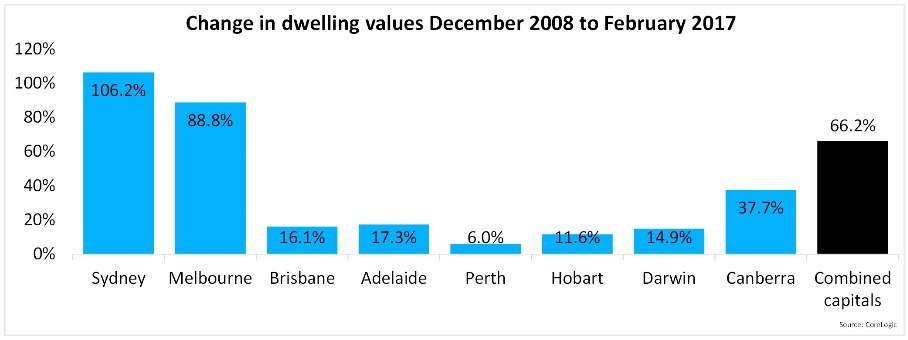CoreLogic’s Cameron Kusher is the latest to call for fundamental reforms to both the demand as supply-sides of the housing market to alleviate affordability pressures in the two major cities:
…housing affordability challenges are largely a Sydney and Melbourne phenomena:
Between December 2008 and June 2016, the increase in population across each state and territory was recorded at: 724,102 persons in NSW, 754,757 in Vic, 568,922 in Qld, 110,303 in SA, 408,244 in WA, 17,354 in Tas, 22,354 in NT and 45,040. NSW and Vic have overwhelmingly seen a much greater increase in population over this period with most of the population flowing into Sydney and Melbourne.
Qld has had the third highest rate of population growth over the period however, it is important to remember that less than a half of the state’s population live in the capital city compared to almost 65% of the NSW population living in Sydney and 76% of Vic’s population living in Melbourne.
The substantial increase in the population of the two largest states has fuelled increasing demand for housing. Especially when you consider that 51.8% of NSW population growth over the period and 62.6% of Vic population growth has come from either net overseas or net interstate migration…
Ultimately, a solution comes down to both supply and demand. Increasing the supply of housing will help but reducing the level of demand for housing could also help to alleviate some of the upwards pressure on housing prices.
The supply of housing can be increased by building more homes, as has occurred over recent years, however, just building more homes is not necessarily enough…
Demand in Sydney and Melbourne is being fuelled by heightened levels of population growth, especially migration, strong job creation and low mortgage rates. Furthermore, the recent strong level of value growth has attracted an increasing number of investors to purchase a property in Sydney and Melbourne. If the goal is to slow the rate of growth in Sydney and Melbourne dwelling values (and I think it should be) curbing demand is a key way to do this.
One obvious way to curb the demand for housing in Sydney and Melbourne is to create demand elsewhere, this may eventually lead to affordability challenges in these alternate regions in the future. Other ways to dampen demand which have been suggested include: removing or changing negative gearing, removing or reducing the capital gains tax discount or a tax on vacant properties. Keep in mind that negative gearing and the capital gains tax discount are available nationwide however, dwelling value growth has only been excessive in recent years in Sydney and Melbourne…
The other source of demand over recent years which has driven demand in Sydney and Melbourne is foreign investment. Unfortunately, regular and accurate data on foreign investment is unavailable, but anecdotally, demand from offshore over recent years has been much higher than it has been in the past…
From a political perspective, politicians do not want to see the cost of housing falling. We are taught that deflation is undesirable and deflation in the value of the country’s most valuable asset class would have a much broader impact on the economy. Keep in mind as well that every property that is rented is owned by someone, some are owned by Government but most rental properties are owned by private citizens…
From a political view the best way to improve housing affordability is to see growth stall for a number of years. This has recently happened in all housing markets outside of Sydney and Melbourne with values having underperformed inflation, it has definitely not been the recent case in the two largest cities.
The way to achieve this is to undertake a wide range of both demand and supply reforms which increase the amount of housing, particularly affordable housing, available to purchase or rent.
Demand for housing in Sydney and Melbourne also needs to be slowed. This can be done via deterrents such as making investment less attractive in these markets through additional fees and charges or changes to the tax system or looking to partner with business to make other locations more desirable by creating more jobs outside of the two largest capital cities. The other way to slow demand in Sydney and Melbourne would be to consider reducing the level of migration to Australia.
Supply side reforms should look at increasing housing supply but this must be done at more affordable price points which means reducing development costs. Governments also need to find ways to discourage developers from holding vast amounts of developable land back from the market and perhaps a tax on undeveloped residential zoned land is a good way to do this.
Supply and demand side reforms will be no easy feat and will require cooperation from all levels of government. But these reforms are vital because it is clear that after such a significant and sustained surge in dwelling values over recent years more needs to be done to temper the growth in the Sydney and Melbourne housing markets.
Well said. And a nice change from the housing industry’s (and Coalition’s) frequent claim that the policy solutions rest solely on the supply-side.


